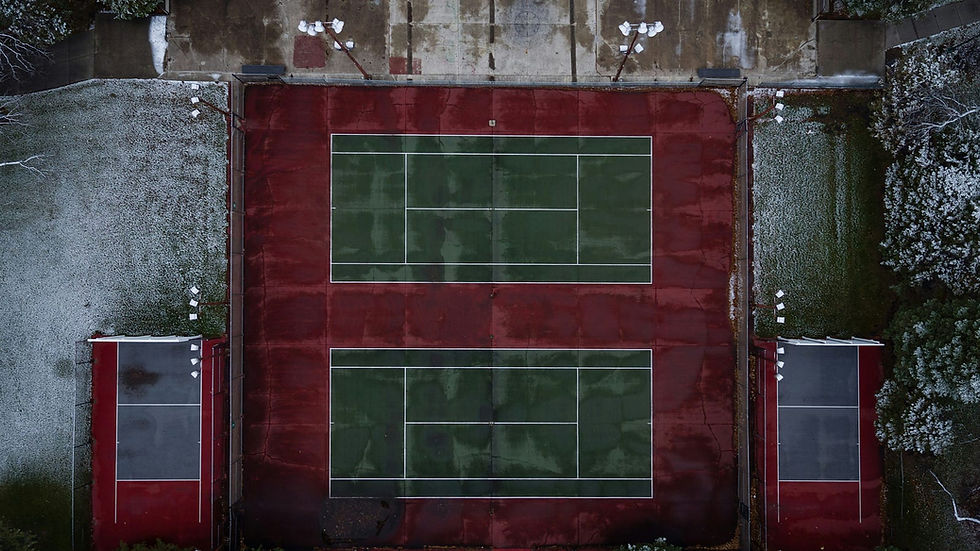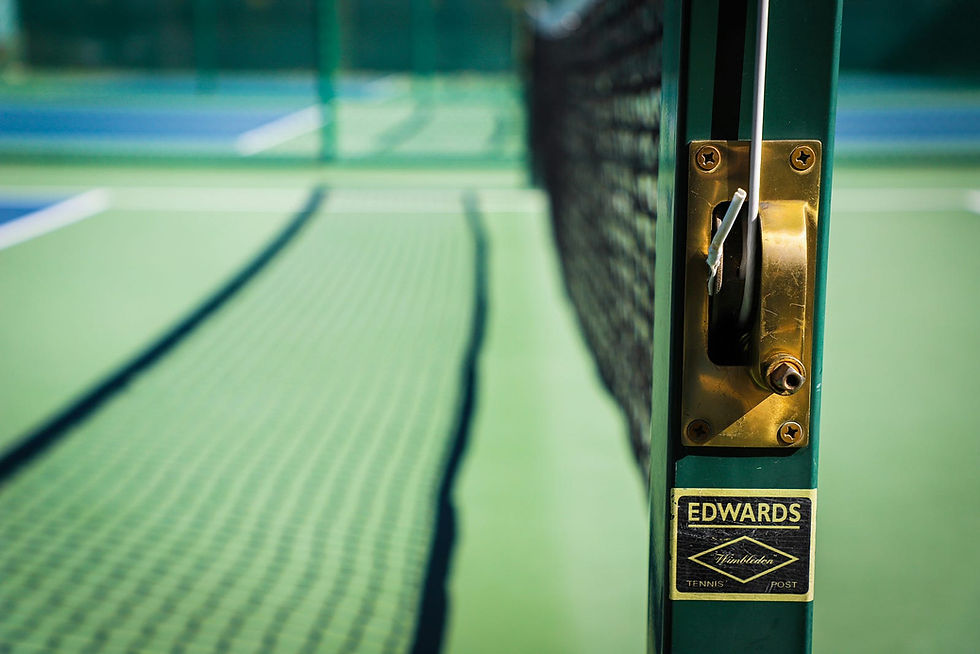From Soccer to Tennis: Why Making the Switch Is a Game-Changer
- Pavł Polø
- Dec 29, 2024
- 4 min read

If you’ve spent years perfecting your soccer game, you’ve likely honed exceptional endurance, agility, and teamwork skills. But have you ever considered switching to tennis? While soccer offers incredible camaraderie and cardio, tennis brings unique advantages that can elevate your athleticism, mental toughness, and even long-term physical health. Whether you’re looking to diversify your skillset, reduce the risk of injuries, or embrace a sport that fosters individual growth, tennis could be your next big win.
In this article, we’ll dive into:
The benefits of switching from soccer to tennis
How tennis offers unique advantages over soccer
A sample tennis training session tailored for soccer players
How tennis improves momentum-building and problem-solving skills
Key stats, tables, and fact-checked insights to guide your decision
Let’s unpack why tennis might just be the perfect second sport for soccer players.
Why Switch to Tennis After Soccer?
1. Physical Benefits of Tennis vs. Soccer
Soccer: A physically demanding team sport that emphasizes aerobic fitness, explosive sprinting, and lower-body strength. However, it often leads to overuse injuries in the knees and ankles due to repetitive actions like sprinting and sudden direction changes.
Tennis: A more balanced full-body workout that enhances cardiovascular endurance, upper-body strength, and hand-eye coordination. Tennis is also gentler on the joints, with fewer high-impact collisions, making it a safer long-term choice.
Key Fact: According to a study in the British Journal of Sports Medicine, tennis players have a 47% lower risk of cardiovascular disease compared to non-tennis players, whereas soccer players often face challenges with joint health over time.
2. Mental Game: Problem Solving & Strategy
Tennis is a mental workout. Unlike soccer, where you rely on teammates, tennis requires you to analyze your opponent's weaknesses, adapt to their strategy, and make split-second decisions—all while staying composed under pressure.
This individual accountability sharpens problem-solving skills, enhances focus, and builds mental resilience. Soccer players often find this transition challenging but rewarding, as it nurtures a self-reliant mindset.

3. Longevity & Accessibility
Soccer is often a young person’s game due to its physical toll. On the other hand, tennis can be played well into your 60s and 70s. Many facilities cater to all age groups, and tennis courts are widely available in local parks, making it a more accessible and lifelong sport.
Benefits of Tennis Compared to Soccer
Feature | Soccer | Tennis |
Physical Intensity | High impact; risk of joint injuries | Moderate impact; full-body workout |
Mental Skills | Team-based strategies | Individual problem-solving |
Longevity | High wear and tear; limited to younger players | Suitable for all ages |
Injury Risk | Common (ankle, knee) | Lower (elbow, wrist) |
Accessibility | Requires a team, field, and equipment | Requires a racket and court |
Cardio Benefits | Excellent for aerobic fitness | Combines cardio with strength training |
How to Switch From Soccer to Tennis: Training Tips
Soccer players bring several transferable skills to tennis, such as footwork, agility, and stamina. However, tennis requires additional focus on hand-eye coordination, upper-body strength, and technical skills like serving and volleying.
Here’s a sample tennis training session tailored for soccer players:
Sample 60-Minute Training Session
Time | Activity | Focus |
5 mins | Dynamic warm-up (jumping jacks, lunges) | Improve mobility and prevent injuries |
10 mins | Agility drills (ladder drills) | Adapt soccer-style footwork to tennis |
15 mins | Serve practice | Build precision and upper-body strength |
10 mins | Rally with a partner | Develop hand-eye coordination and consistency |
15 mins | Match play | Apply strategy and problem-solving skills |
5 mins | Cool down (stretching) | Prevent muscle soreness |
Pro Tip:
Soccer players transitioning to tennis should prioritize learning proper racket grip, swing mechanics, and foot placement during serves. These are foundational skills that can make or break your game.

Building Momentum in Tennis
In tennis, momentum often shifts with every point. Unlike soccer, where a lead can be defended for extended periods, tennis demands constant focus and adaptability. Here’s how soccer players can excel in momentum-building during tennis matches:
Stay Mentally Flexible: Learn to reset quickly after losing a point. Soccer’s emphasis on resilience after conceding a goal can help.
Capitalize on Your Opponent’s Weaknesses: Soccer players already analyze team dynamics; apply this skill to exploit gaps in your opponent’s game.
Physical Endurance: Soccer players often have superior stamina, allowing them to outlast opponents during long rallies.
Tennis as a Problem-Solving Sport
Tennis is often described as “chess at 100 mph” because of the tactical decision-making involved. Each serve, return, and volley requires players to assess the situation and choose the best response. For soccer players, this shift from team-based problem-solving to individual strategy can be challenging but immensely rewarding.
Key Problem-Solving Scenarios in Tennis:
Adapting to Opponent’s Style: Is your opponent aggressive or defensive? Adjust your gameplay to counter their strengths.
Managing Fatigue: Long matches test your endurance and decision-making under pressure.
Reading the Court: Soccer players are already adept at spatial awareness, making it easier to predict ball trajectories and position themselves effectively.
Common Pain Points and How Tennis Addresses Them
Pain Point | How Tennis Helps |
Overuse Injuries (e.g., knees) | Lower-impact sport reduces joint strain |
Limited Playtime After Injury | Tennis allows for gradual return to activity |
Team Dependency | Tennis fosters self-reliance and accountability |
Burnout from Rigorous Schedules | Flexible practice schedules suit all lifestyles |
Conclusion: Why Tennis Could Be Your Next Big Move
Switching from soccer to tennis offers numerous benefits, from reducing injury risk to fostering mental toughness and providing lifelong play opportunities. For soccer players seeking a fresh challenge or looking to stay active beyond their prime, tennis is an excellent choice.
Remember, the transition might require patience and practice, but your soccer skills—especially agility and endurance—will give you a head start. So grab a racket, hit the court, and experience the game-changing benefits of tennis!
Fact-Check and Sources
British Journal of Sports Medicine: Study on cardiovascular benefits of tennis vs. soccer.
American College of Sports Medicine (ACSM): Data on injury prevalence in soccer and tennis.
National Institutes of Health (NIH): Research on the psychological benefits of tennis.
For further reading:
Are you ready to take your skills from the soccer field to the tennis court? Share your thoughts or questions in the comments below!
LINKS:
Instagram: @pavl_polo
Listen to Pavł Polø here:
YouTube: https://bit.ly/3BdvcD1
Spotify: https://sptfy.com/7p7W
Apple Music: https://apple.co/3rEXLpO
Deezer: https://bit.ly/3rGoTVz
Tidal: https://bit.ly/3oBmaeg

Comentarios